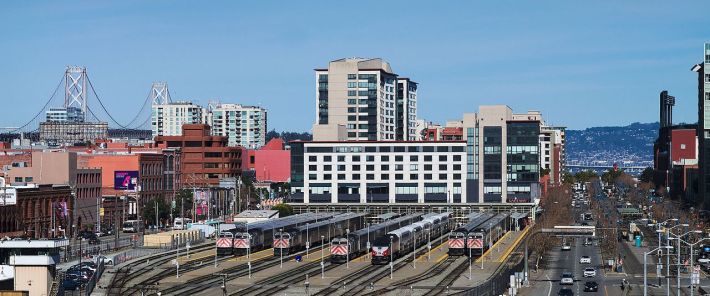As a Streetsblog source predicted, inspectors found a second crack in the Salesforce Transit Center. The Transbay Joint Powers Authority announced that the center will be closed at least through next week while they develop a plan to shore up and repair the damage.
One report described the situation as having driven "downtown San Francisco into chaos."
I took a Transbay bus during the height of rush hour yesterday morning. It was slow, but it went to the re-opened, ground-level Temporary Transbay Transit Center at Howard and Beale. Frankly, it didn't seem any different from the way Transbay bus commuting has been for the past eight years. If there was chaos, it was probably more attributable to the Dreamforce conference.
But let's imagine it's a decade or two in the future. Electrified Caltrain trains have been running into the basement of Transbay for a year, carrying 80,000 commuters every day.
A small temblor hits at 12 a.m. It's enough to crack a few windows and scare the bejeebers out of people, but no real damage is apparent. The Salesforce Transit Center was designed to withstand far worse. But on inspection, engineers discover more cracked beams. Transbay has to be closed again.
Reroute the buses to the old Temporary facility? It's been converted into housing and a park and the bus slips are long gone. Divert the trains to the old Caltrain depot? No, can't do that either. The old surface tracks were ripped out a few months ago to make way for a new development.

Yeah, that would be chaos.
Transit systems in cities overseas are more reliable, in large part, because they have built-in redundancies. Bomb scare at Victoria Station in London? Your commuter train is re-routed to Waterloo Station instead. Your subway's out at Shibuya in Tokyo because of a sick passenger? Take the Yamanote surface line. Your E train is out and you can't get to New York's Queensboro Plaza? Take the 7 train. San Francisco has only a tiny bit of redundancy; politicos riding the J Church were able to walk to BART and still get to City Hall for Monday's Transit Week's kickoff ceremony. But SF transit is way too vulnerable to meltdowns. Think of BART's debacle last year because a motorist hit a telephone pole in West Oakland.
There is no shortage of plans to move transportation infrastructure projects forward in San Francisco. But there's no sense of urgency. And when things are built, officials seem eager to eliminate redundancies.
Let these cracks be a lesson. It's okay to build a park on the Temporary Transbay site, but figure out a way to do it with roadways and bus bays still there, perhaps disguised as something else, with benches and park furniture that can be quickly removed. Want to get trains into the basement of Transbay? Don't dicker around with alternate alignments, when you've already got one approved. And once it's built, nobody should be talking about tearing out the existing surface tracks and station--leave them in, use them for occasional rush-hour service and maintenance trains, and keep them available for emergencies. Build above them if we must.
As the cliche goes, hope for the best, but plan for the worst. Let's get that second Transbay tube, the bike way on the western span of the bridge, and increased ferry service online as soon as possible. Let's build and maintain redundancy and transportation alternatives wherever possible.
Because this time the city got lucky; there was a plan 'B'. But if we don't start intentionally building redundancies, some day one small crack at a key location will break the whole city.





